Delineation of Hydrochemical Characteristics and Tracing Nitrate Contamination of Groundwater Based on Hydrochemical Methods and Isotope Techniques in the Northern Huangqihai Basin, China
Abstract
:1. Introduction
2. Materials and Methods
2.1. Study Area
2.2. Data Preparation and Methods
2.2.1. Data Preparation
2.2.2. Methods
- (1)
- Mole fraction
- (2)
- Shukalev classification
- (3)
- Cation exchange
- (4)
- Isotope values
- (5)
- Evaluation of groundwater quality
- (6)
- Denitrification and nitrification
- (7)
- δ15N(NO3) – δ18O(NO3) dual isotope technique
3. Results
3.1. Hydrochemical Characteristics Analysis
3.2. Hydrochemical Evolution Mechanism
3.2.1. Hydrochemical Process
3.2.2. Analysis of the Main Dissolution and Migration
- (1)
- (Ca2+ + Mg2+)/(HCO3− + SO42−)
- (2)
- Ca2+/Mg2+
- (3)
- Na+/Cl− and Na+/HCO3−
- (4)
- (SO42− + Cl−)/HCO3−
3.2.3. Cation Exchange
- (1)
- (Na+ − Cl−) vs. (Ca2+ + Mg2+ − SO42− – HCO3−)
- (2)
- Chloro–alkaline indices
3.3. Groundwater Source
3.4. Evaluation of Groundwater Quality
3.5. Identification of Nitrogen Contamination
3.5.1. Relationship between NO3− and Other Ions (Cl−, SO42−, Na+ and K+)
3.5.2. Denitrification and Nitrification
3.5.3. δ15. N(NO3) – δ18O(NO3) Dual Isotope Technique
4. Conclusions
Author Contributions
Funding
Institutional Review Board Statement
Informed Consent Statement
Data Availability Statement
Acknowledgments
Conflicts of Interest
References
- He, X.D.; Li, P.Y.; Ning, J.; He, S.; Yang, N.N. Geochemical processes during hydraulic fracturing in a tight sandstone reservoir revealed by field and laboratory experiments. J. Hydrol. 2022, 612, 128292. [Google Scholar] [CrossRef]
- Fuoco, I.; Rosa, D.R.; Barca, D.; Figoli, A.; Gabriele, B.; Apollaro, C. Arsenic polluted waters: Application of geochemical modelling as a tool to understand the release and fate of the pollutant in crystalline aquifers. J. Environ. Manag. 2022, 301, 113796. [Google Scholar] [CrossRef] [PubMed]
- Fuoco, I.; Marini, L.; De Rosa, R.; Figoli, A.; Gabriele, B.; Apollaro, C. Use of reaction path modelling to investigate the evolution of water chemistry in shallow to deep crystalline aquifers with a special focus on fluoride. Sci. Total Environ. 2022, 830, 154566. [Google Scholar] [CrossRef]
- Shi, X.Y.; Wang, Y.; Jiao, J.J.; Zhong, J.L.; Wen, H.G.; Dong, R. Assessing major factors affecting shallow groundwater geochemical evolution in a highly urbanized coastal area of Shenzhen City, China. J. Geochem. Explor. 2018, 184, 17–27. [Google Scholar] [CrossRef]
- Ren, C.B.; Zhang, Q.Q. Groundwater chemical characteristics and controlling factors in a region of northern China with intensive human activity. Int. J. Env. Res. Public Health 2020, 17, 9126. [Google Scholar] [CrossRef] [PubMed]
- Su, F.; Wu, J.; Wang, D.; Zhao, H.; Wang, Y.; He, X. Moisture movement, soil salt migration, and nitrogen transformation under different irrigation conditions: Field experimental research. Chemosphere 2022, 300, 134569. [Google Scholar] [CrossRef] [PubMed]
- Anornu, G.; Gibrilla, A.; Adomako, D. Tracking nitrate sources in groundwater and associated health risk for rural communities in the White Volta River basin of Ghana using isotopic approach (δ15N, δ18O–NO3 and 3H). Sci. Total Environ. 2016, 603–604, 687–698. [Google Scholar] [CrossRef] [PubMed]
- Hu, M.M.; Wang, Y.C.; Du, P.C.; Shui, Y.; Cai, A.M.; Lu, C.; Bao, Y.F.; Li, Y.H.; Li, S.Z.; Zhang, P.W. Tracing the sources of nitrate in the rivers and lakes of the southern areas of the Tibetan Plateau using dual nitrate isotopes. Sci. Total Environ. 2019, 658, 132–140. [Google Scholar] [CrossRef]
- Li, P.Y.; He, X.D.; Guo, W.Y. Spatial groundwater quality and potential health risks due to nitrate ingestion through drinking water: A case study in Yan’an City on the Loess Plateau of northwest China. Hum. Ecol. Risk Assess. 2019, 25, 11–31. [Google Scholar] [CrossRef]
- Mayo, A.L.; Tingey, D.G. Shallow groundwater chemical evolution, isotopic hyperfiltration, and salt pan formation in a hypersaline endorheic basin: Pilot Valley, Great Basin, USA. Hydrogeol. J. 2021, 29, 2219–2243. [Google Scholar] [CrossRef]
- Dowling, C.B.; Poreda, R.J.; Basu, A.R.; Peters, S.L.; Aggarwal, P.K. Geochemical study of arsenic release mechanisms in the Bengal Basin groundwater. Water Resour. Res. 2002, 38, 1173. [Google Scholar] [CrossRef] [Green Version]
- Banda, K.E.; Wilson, M.; Rasmus, J.; Jason, O.; Imasiku, N.; Flemming, L. Mechanism of salinity change and hydrogeochemical evolution of groundwater in the Machile–Zambezi Basin, South–western Zambia. J. Afr. Earth Sci. 2019, 153, 72–82. [Google Scholar] [CrossRef]
- Nipada, S.; Saowani, S.; Schradh, S. Arsenic contamination in groundwater and potential health risk in western Lampang Basin, northern Thailand. Water 2022, 14, 465. [Google Scholar] [CrossRef]
- Wen, Y.; Qiu, J.H.; Cheng, S.; Xu, C.C.; Gao, X.J. Hydrochemical evolution mechanisms of shallow groundwater and its quality assessment in the estuarine coastal zone: A case study of Qidong, China. Int. J. Env. Res. Pub. He. 2020, 17, 3382. [Google Scholar] [CrossRef]
- Zhang, Y.H.; Xu, M.; Li, X.; Qi, J.H.; Zhang, Q.; Guo, J.; Yu, L.L.; Zhao, R. Hydrochemical characteristics and multivariate statistical analysis of natural water system: A case study in Kangding county, southwestern China. Water 2018, 10, 80. [Google Scholar] [CrossRef] [Green Version]
- Su, H.; Kang, W.D.; Kang, N.; Liu, J.T.; Li, Z. Hydrogeochemistry and health hazards of fluoride–enriched groundwater in the Tarim Basin, China. Environ. Res. 2021, 200, 111476. [Google Scholar] [CrossRef] [PubMed]
- Feng, F.; Jia, Y.F.; Yang, Y.; Huan, H.; Lian, X.Y.; Xu, X.J.; Xia, F.; Han, X.; Jiang, Y.H. Hydrogeochemical and statistical analysis of high fluoride groundwater in northern China. Environ. Sci. Pollut. Res. Int. 2020, 27, 34840–34861. [Google Scholar] [CrossRef]
- Chen, Z.X.; Yu, L.; Liu, W.G.; Lam, M.H.W. Nitrogen and oxygen isotopic compositions of water–soluble nitrate in Taihu Lake water system, China: Implication for nitrate sources and biogeochemical process. Env. Earth Sci. 2014, 71, 217–223. [Google Scholar] [CrossRef]
- Mukherjee, I.; Singh, U.K. Characterization of groundwater nitrate exposure using Monte Carlo and Sobol sensitivity approaches in the diverse aquifer systems of an agricultural semiarid region of Lower Ganga Basin, India. Sci. Total Environ. 2021, 787, 147657. [Google Scholar] [CrossRef]
- Avilés, F.; Patricia, G.; Lorenzo, S.; Elisa, S.; Yvan, R.; Joel, S.; Eduardo, R.O.; Céline, D. Hydrogeochemical and nitrate isotopic evolution of a semiarid mountainous basin aquifer of glacial–fluvial and paleolacustrine origin (Lake Titicaca, Bolivia): The effects of natural processes and anthropogenic activities. Hydrogeol. J. 2022, 30, 181–202. [Google Scholar] [CrossRef]
- Chen, J.Q.; Lv, J.M.; Wang, Q.W.; Wang, J. External Groundwater alleviates the degradation of closed lakes in semi–arid regions of China. Remote Sens. 2019, 12, 45. [Google Scholar] [CrossRef] [Green Version]
- Han, X.Q.; Lin, J.; Yang, Y.; Sun, X.M.; Zhu, X.L.; Wu, J.F.; Wu, J.C. Three–dimensional modeling and visualization of hydrogeological structure in water supply well fields of Jining district, Inner Mongolia. J. Inn. Mong. Agric. Univ. 2017, 38, 45–52. (In Chinese) [Google Scholar] [CrossRef]
- Chen, M.M.; Liu, J.G. Historical trends of wetland areas in the agriculture and pasture interlaced zone: A case study of the Huangqihai Lake Basin in northern China. Ecol. Model. 2015, 318, 168–176. [Google Scholar] [CrossRef]
- Tian, F.; Wang, Y.; Zhao, Z.L.; Dong, J.; Liu, J.; Ling, Y.; Yuan, Y.P.; Ye, M.N. Holocene vegetation and climate changes in the Huangqihai Lake region, Inner Mongolia. Acta Geol. Sin. 2020, 94, 1178–1186. [Google Scholar] [CrossRef]
- Fu, Y.C.; Zhao, J.Y.; Peng, W.Q.; Zhu, G.P.; Quan, Z.J.; Li, C.H. Spatial modelling of the regulating function of the Huangqihai Lake wetland ecosystem. J. Hydro. 2018, 564, 283–293. [Google Scholar] [CrossRef]
- Guo, Z.X.; Hao, W.G.; Zhang, S.; Zhang, Z.G. Evaluation on present situation of water environmental quality in Huangqihai Lake. Chin. Agric. Sci. Bull. 2007, 23, 346–350. (In Chinese) [Google Scholar] [CrossRef]
- Hao, W.G.; Bao, X.Q.; Wei, Y.F.; Guo, Z.X.; Zhuang, J.; Liang, J. Eutrophication and its dynamic changes in Huangqihai lake. Yellow River 2008, 30, 74–75. (In Chinese) [Google Scholar] [CrossRef]
- GB/T14848-2017; Standard for Groundwater Quality. Standards Press of China: Beijing, China, 2017. (In Chinese)
- DZ/T 0064-2021; Analysis Method of Groundwater Quality. Standards Press of China: Beijing, China, 2021. (In Chinese)
- China Geological Survey. Handbook of Hydrogeology, 2nd ed.; Geological Publishing House: Beijing, China, 2018; pp. 108–110.
- Qian, H.; Ma, Z.Y. Hydrogeochemistry; Geology Publishing House: Beijing, China, 2005. (In Chinese) [Google Scholar]
- Piper, A.M. A graphic procedure in the geochemical interpretation of water analysis. Trans. Am. Geophys. Union 1944, 25, 914–928. [Google Scholar] [CrossRef]
- Gibbs, R.J. Mechanisms controlling world water chemistry. Science 1970, 170, 1088–1090. [Google Scholar] [CrossRef]
- Lachaal, F.; Messaoud, R.B.; Jellalia, D.; Chargui, S.; Chekirbane, A.; Mlayah, A.; Massuel, S.; Leduc, C. Impact of water resources management on groundwater hydrochemical changes: A case of Grombalia shallow aquifer, NE of Tunisia. Arab. J. Geosci. 2018, 11, 304. [Google Scholar] [CrossRef]
- Lachache, S.; Nabou, M.; Merzouguui, T.; Amroune, A. Hydrochemistry and origin of principal major elements in the groundwater of the Béchar–Kénadsa basin in arid zone, south–west of Algeria. J. Water Land Dev. 2018, 36, 77–87. [Google Scholar] [CrossRef] [Green Version]
- Eskandari, E.; Mohammadzadeh, H.; Nassery, H.; Vadiati, M.; Zadeh, A.M.; Kisi, O. Delineation of isotopic and hydrochemical evolution of karstic aquifers with different cluster–based (HCA, KM, FCM and GKM) methods. J. Hydrol. 2022, 609, 127706. [Google Scholar] [CrossRef]
- Apollaro, C.; Di Curzio, D.; Fuoco, I.; Buccianti, A.; Dinelli, E.; Vespasiano, G.; Castrignanò, A.; Rusi, S.; Barca, D.; Figoli, A.; et al. A multivariate non–parametric approach for estimating probability of exceeding the local natural background level of arsenic in the aquifers of Calabria region (Southern Italy). Sci. Total Environ. 2022, 806, 150345. [Google Scholar] [CrossRef] [PubMed]
- Deepika, B.V.; Ramakrishnaiah, C.R.; Naganna, S.R. Spatial variability of ground water quality: A case study of Udupi district, Karnataka State, India. J. Earth Syst. Sci. 2020, 129, 221. [Google Scholar] [CrossRef]
- Kpaйнoв, C.P.; Фoйгт, Г.Ю.; Wang, Y.X. Geochemical and ecological consequences of changes in groundwater chemical composition under the influence of pollutants. J. Geosci. Transl. 1992, 19, 73–80. (In Chinese) [Google Scholar] [CrossRef]
- Huang, G.X.; Liu, C.Y.; Sun, J.C.; Zhang, M.; Jing, J.H.; Li, L.P. A regional scale investigation on factors controlling the groundwater chemistry of various aquifers in a rapidly urbanized area: A case study of the Pearl River Delta. Sci. Total Environ. 2018, 625, 510–518. [Google Scholar] [CrossRef]
- Hu, C.P.; Liu, Z.Q.; Xiong, K.N.; Lyu, X.X.; Li, Y.; Zhang, R.K. Characteristics of and influencing factors of hydrochemistry and carbon/nitrogen variation in the Huangzhouhe river basin, a World Natural Heritage Site. Int. J. Environ. Res. Public Health 2021, 18, 13169. [Google Scholar] [CrossRef]
- Heaton, T.H.E. Isotopic studies of nitrogen pollution in the hydrosphere and atmosphere: A review. Chem. Geol. Isot. Geosci. Sect. 1986, 59, 87–102. [Google Scholar] [CrossRef]
- Adebowale, T.; Surapaneni, A.; Faulkner, D.; McCance, W.; Wang, S.Q.; Currell, M. Delineation of contaminant sources and denitrification using isotopes of nitrate near a wastewater treatment plant in peri-urban settings. Sci. Total Environ. 2019, 65, 2701–2711. [Google Scholar] [CrossRef]
- Widory, D.; Petelet, G.E.; Négrel, P.; Ladouche, B. Tracking the sources of nitrate in groundwater using coupled nitrogen and boron isotopes: A synthesis. Environ. Sci. Tech. 2005, 39, 539–548. [Google Scholar] [CrossRef]
- Bottcher, J.; Sreebel, O.; Voerkelius, S.; Schmidt, H.L. Using isotope fractionation of nitrate–nitrogen and nitrate–oxygen for evaluation of microbial denitrification in a sandy aquifer. J. Hydrol. 1990, 114, 413–424. [Google Scholar] [CrossRef]
- Fukada, T.; Hiscock, K.M.; Dennis, P.F.; Grischek, T. A dual isotope approach to identify denitrification in groundwater at a river–bank infiltration site. Water Res. 2003, 37, 3070–3078. [Google Scholar] [CrossRef]
- Xue, D.M.; Botte, J.; De, B.B.; Accoe, F.; Nestler, A.; Taylor, P.; Van, C.O.; Berglund, M.; Boeckx, P. Present limitations and future prospects of stable isotope methods for nitrate source identification in surface and groundwater. Water Res. 2009, 43, 1159–1170. [Google Scholar] [CrossRef] [PubMed]
- Andrew, A.A.; Jun, S.; Takahiro, H.; Makoto, K.; Akoachere, R.; George, E.N.; Aka, F.T.; Ono, M.; Eyong, G.E.T.; Tandia, B.K. Flow dynamics and age of groundwater within a humid equatorial active volcano (Mount Cameroon) deduced by δD, δ18O, 3H and chlorofluorocarbons (CFCs). J. Hydrol. 2013, 502, 156–176. [Google Scholar] [CrossRef]
- Liao, H.W.; Jiang, Z.C.; Zhou, H.; Qin, X.Q.; Huang, Q.B. Isotope–based study on nitrate sources in a karst wetland water, southwest China. Water 2022, 14, 1533. [Google Scholar] [CrossRef]
- Raj, P.S.; Prasad, B.S.; Amrita, W.; Friedemann, F.T. Earthquake chemical precursors in groundwater: A review. J. Seismol. 2018, 22, 1293–1314. [Google Scholar] [CrossRef]
- Skelton, A.; Liljedahl-Claesson, L.; Wästeby, N.; Andrén, M.; Stockmann, G.; Sturkell, E.; Mörth, C.M.; Stefansson, A.; Tollefsen, E.; Siegmund, H.; et al. Hydrochemical changes before andafter earthquakes based on long-termmeasurements of multiple parametersat two sites in northern Iceland–Areview. J. Geophys. Res. Sol. Ea. 2019, 124, 2702–2720. [Google Scholar] [CrossRef]
- Peng, C.; He, J.T.; Liao, L.; Zhang, Z.G. Research on the influence degree of human activities on groundwater quality by the method of geochemistry: A case study from Liujiang Basin. Earth Sci. Front. 2017, 24, 321–331. (In Chinese) [Google Scholar] [CrossRef]
- Apollaro, C.; Vespasiano, G.; De Rosa, R.; Marini, L. Use of mean residence time and flowrate of thermal waters to evaluate the volume of reservoir water contributing to the natural discharge and the related geothermal reservoir volume. Application to Northern Thailand hot springs. Geothermics 2015, 58, 62–74. [Google Scholar] [CrossRef]
- Li, J.X.; Zhou, H.L.; Qian, K.; Xie, X.J.; Xue, X.B.; Yang, Y.J.; Wang, Y.X. Fluoride and iodine enrichment in groundwater of north China plain: Evidences from speciation analysis and geochemical modeling. Sci. Total Environ. 2017, 598, 239–248. [Google Scholar] [CrossRef]
- Singh, G.; Rishi, M.S.; Herojeet, R.; Kaur, L.; Sharma, K. Evaluation of groundwater quality and human health risks from fluoride and nitrate in semi–arid region of northern India. Environ. Geochem. Health 2020, 42, 1833–1862. [Google Scholar] [CrossRef] [PubMed]
- An, Y.K.; Lu, W.X. Hydrogeochemical processes identification and groundwater pollution causes analysis in the northern Ordos Cretaceous Basin, China. Environ. Geochem. Health 2017, 40, 1209–1219. [Google Scholar] [CrossRef] [PubMed]
- Farid, I.; Zouari, K.; Rigane, A.; Beji, R. Origin of the groundwater salinity and geochemical processes in detrital and carbonate aquifers: Case of Chougafiya basin (Central Tunisia). J. Hydrol. 2015, 530, 508–532. [Google Scholar] [CrossRef]
- Capuano, R.M.; Jones, C.R. Cation exchange in groundwater-chemical evolution and prediction of paleo-groundwater flow: A natural-system study. Water Resour. Res. 2020, 56, e2019WR026318. [Google Scholar] [CrossRef]
- Eaman, S.; De Louw, P.G.B.; Van der Zee, S.E.A.T.M. Cation exchange in a temporally fluctuating thin freshwater lens on top of saline groundwater. Hydrogeol. J. 2017, 25, 223–241. [Google Scholar] [CrossRef] [Green Version]
- Craig, H. Isotopic variations in meteoric waters. Science 1961, 133, 1702–1703. [Google Scholar] [CrossRef]
- Guo, X.; Li, W.B.; Du, L.; Jia, D.B.; Liu, T.X. Characteristics and influence factors for the hydrogen and oxygen isotopic of precipitation in inner Mongolia. China Environ. Sci. 2022, 42, 1088–1096. (In Chinese) [Google Scholar] [CrossRef]
- Dansgaard, W. Stable isotopes in precipitation. Tellus 1964, 16, 436–468. [Google Scholar] [CrossRef]
- Claus, K.; Rolf, F.R.; Fernando, R.B.; Iñaki, V. Vapor source and spatiotemporal variation of precipitation isotopes in southwest Spain. Hydrol. Process. 2021, 35, e14445. [Google Scholar] [CrossRef]
- Chen, X.; Jiang, C.L.; Zheng, L.G.; Zhang, L.Q.; Fu, X.J.; Chen, S.G.; Chen, Y.C.; Hu, J. Evaluating the genesis and dominant processes of groundwater salinization by using hydrochemistry and multiple isotopes in a mining city. Environ. Pollut. 2021, 283, 117381. [Google Scholar] [CrossRef]
- Xia, C.; Liu, G.; Mei, J.; Meng, Y.; Hu, Y. Characteristics of hydrogen and oxygen stable isotopes in precipitation and the environmental controls in tropical monsoon climatic zone. Int. J. Hydrog. Energy. 2019, 44, 5417–5427. [Google Scholar] [CrossRef]
- Wang, C.; Zhang, H.; Lei, P.; Xin, X.K.; Zhang, A.J.; Yin, W. Evidence on the causes of the rising levels of CODMn along the middle route of the South–to–North Diversion Project in China: The role of algal dissolved organic matter. J. Environ. Sci. 2022, 113, 281–290. [Google Scholar] [CrossRef] [PubMed]
- Koba, K.; Tokuchi, N.; Wada, E.; Nakajima, T.; Iwatsubo, G. Intermittent denitrification: The application of a 15N natural abundance method to a forested ecosystem. Geochim. Cosmochim Ac. 1997, 61, 5043–5050. [Google Scholar] [CrossRef]
- Kendall, C. Tracing nitrogen sources and cycling in catchments. Isot. Tracers Catchment Hydrol. 1998, 1, 519–576. [Google Scholar] [CrossRef]
- Amberger, A.; Schmidt, H.L. Natürliche isotopengehalte von nitrat als indikatoren für dessen herkunft. Geochim. Et Cosmochim. Acta 1987, 51, 2699–2705. [Google Scholar] [CrossRef]
- Kent, R.; Landon, M.K. Trends in concentrations of nitrate and total dissolved solids in public supply wells of the Bunker Hill, Lytle, Rialto, and Colton groundwater sub basins, San Bernardino county, California: Influence of legacy land use. Sci. Total Environ. 2013, 452–453, 125–136. [Google Scholar] [CrossRef]

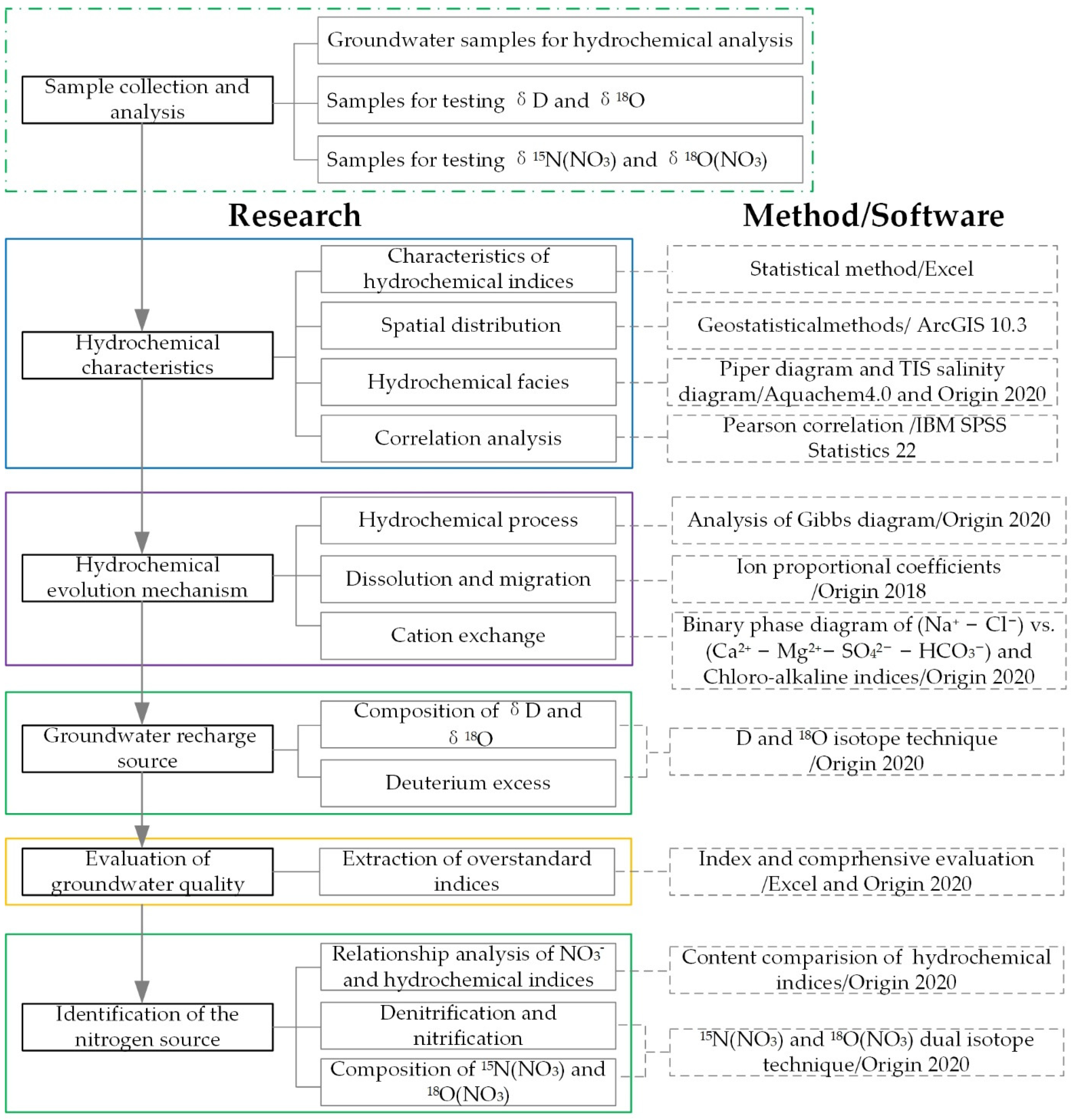
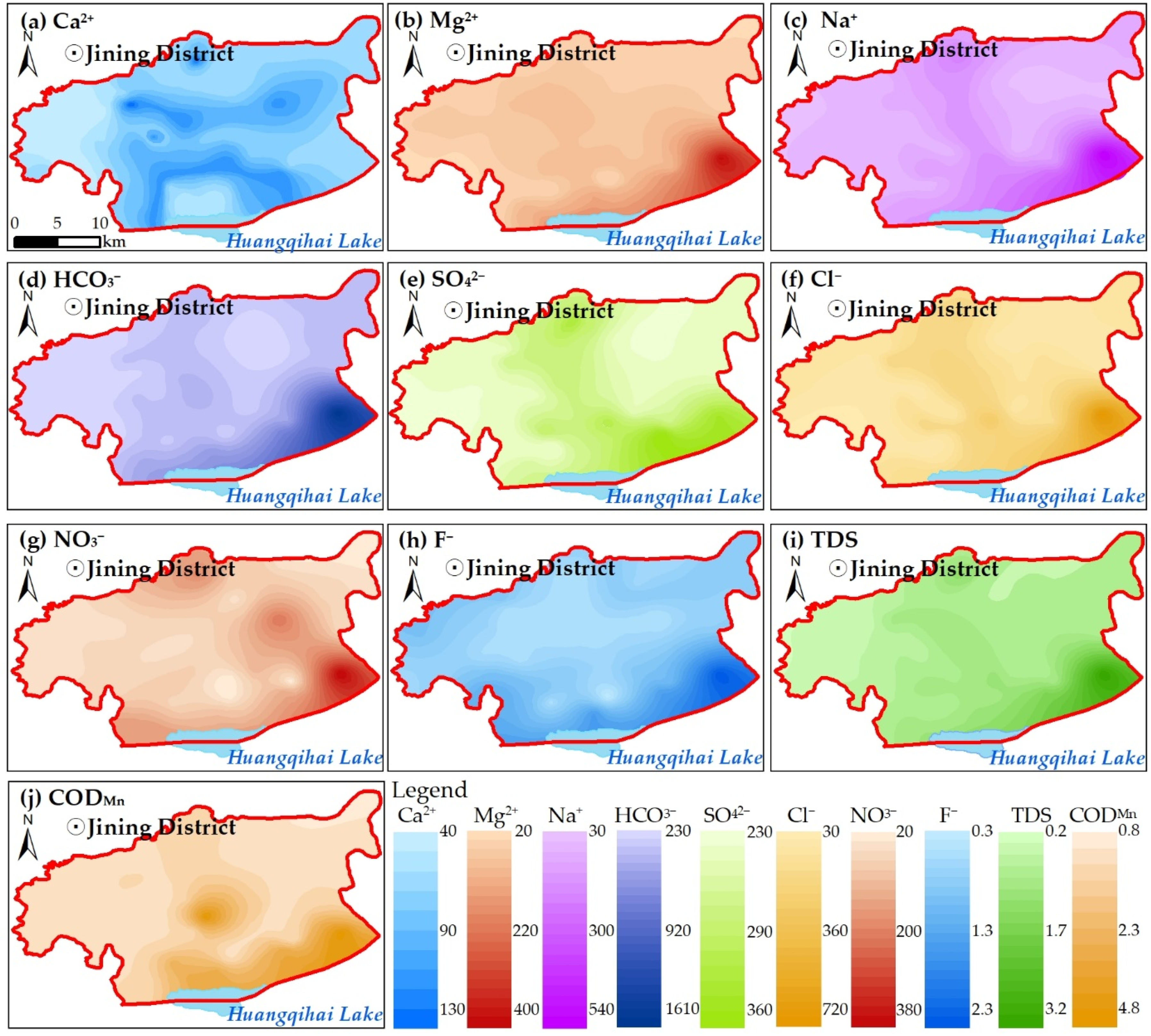
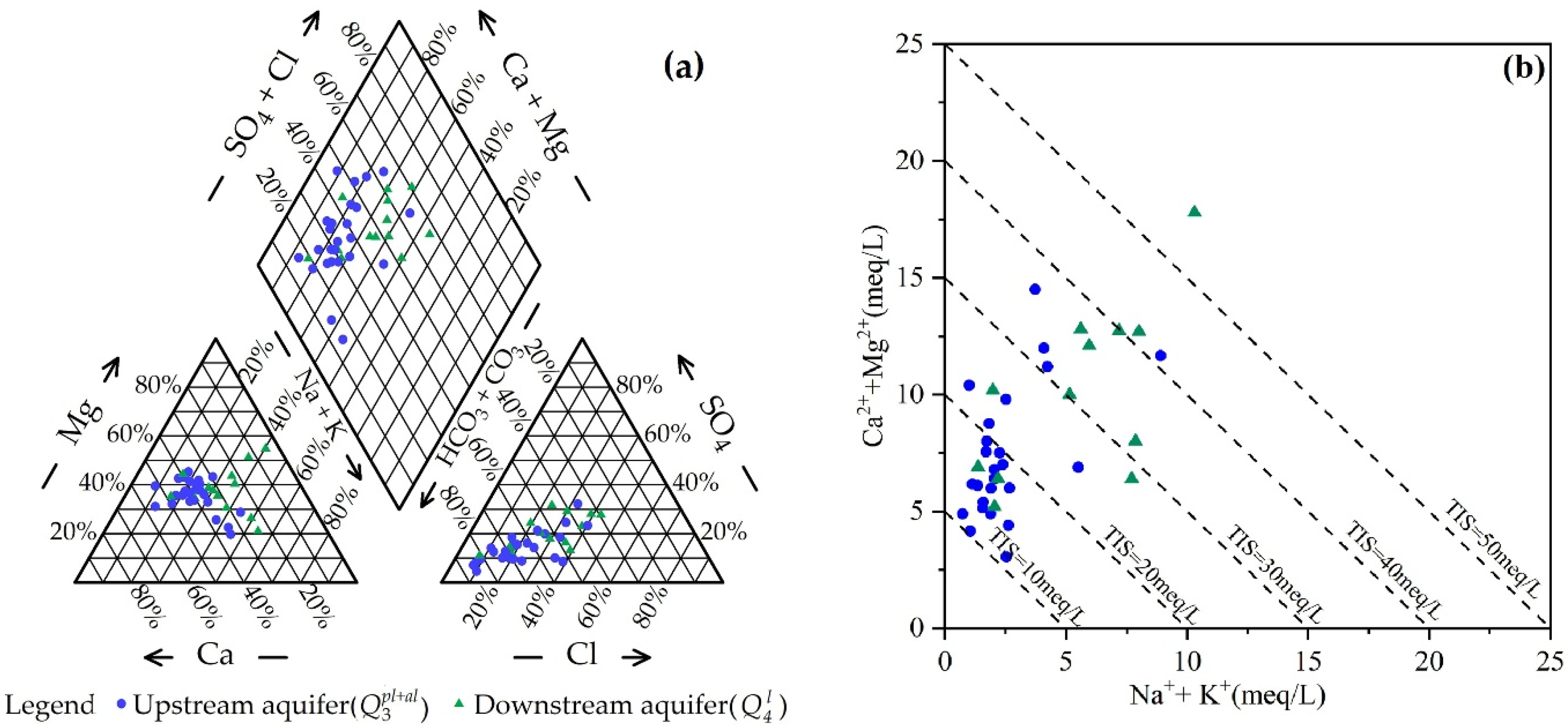
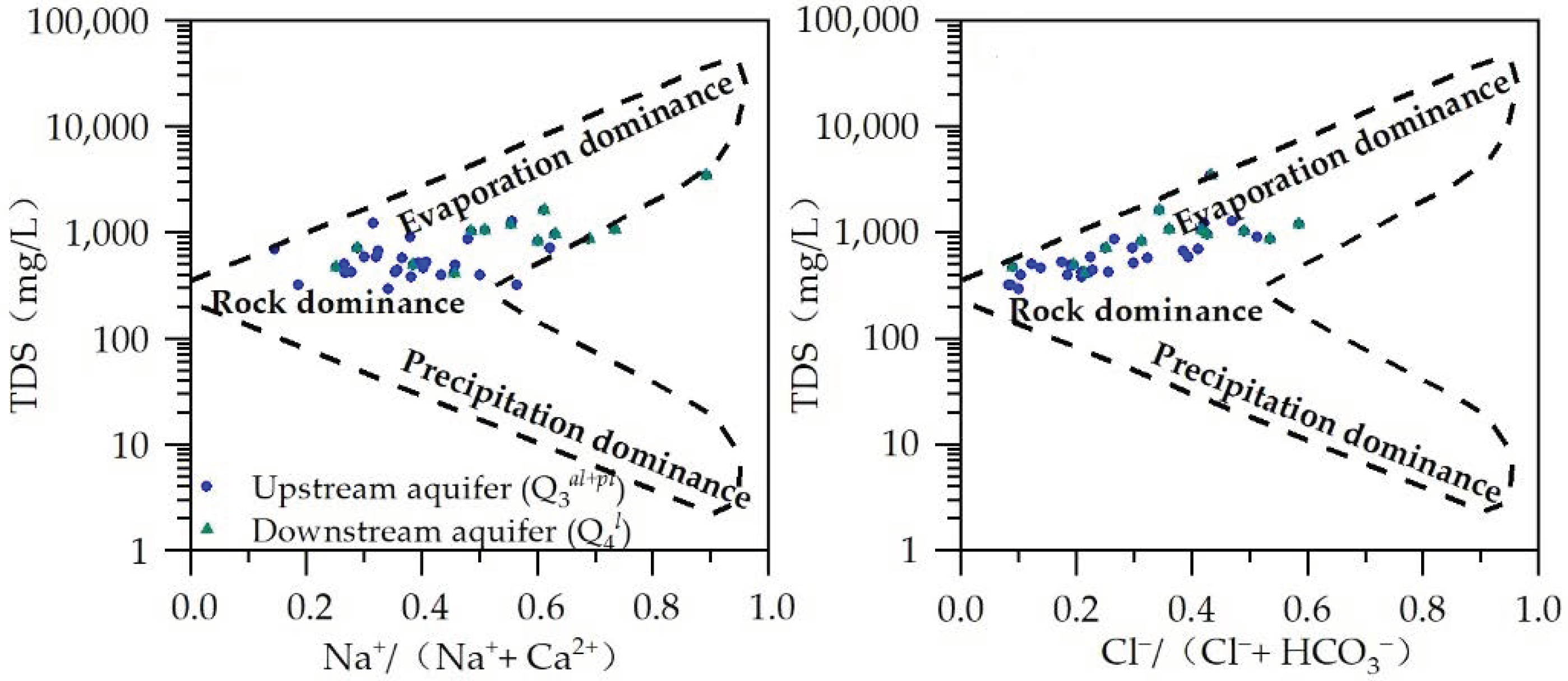
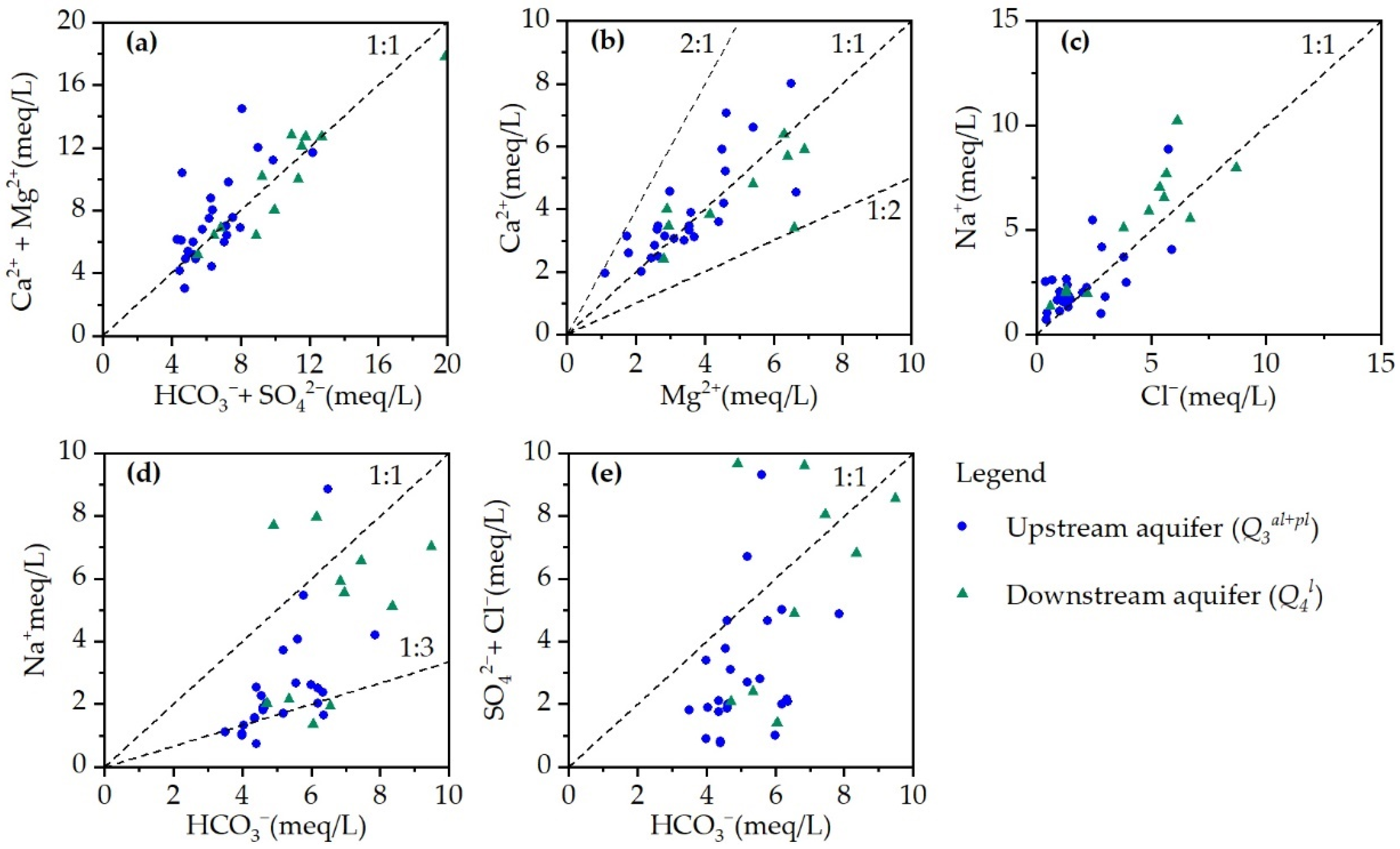
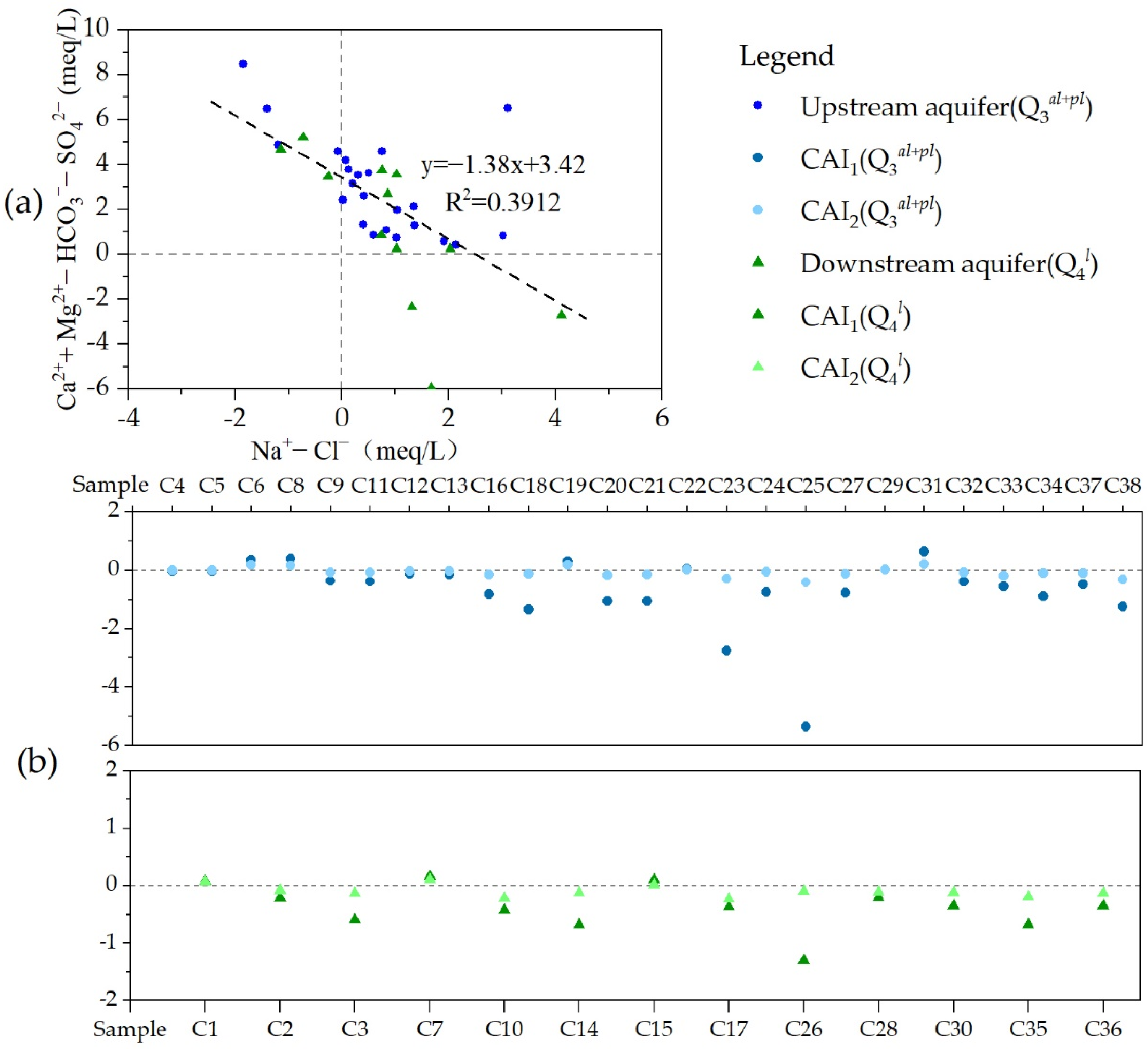

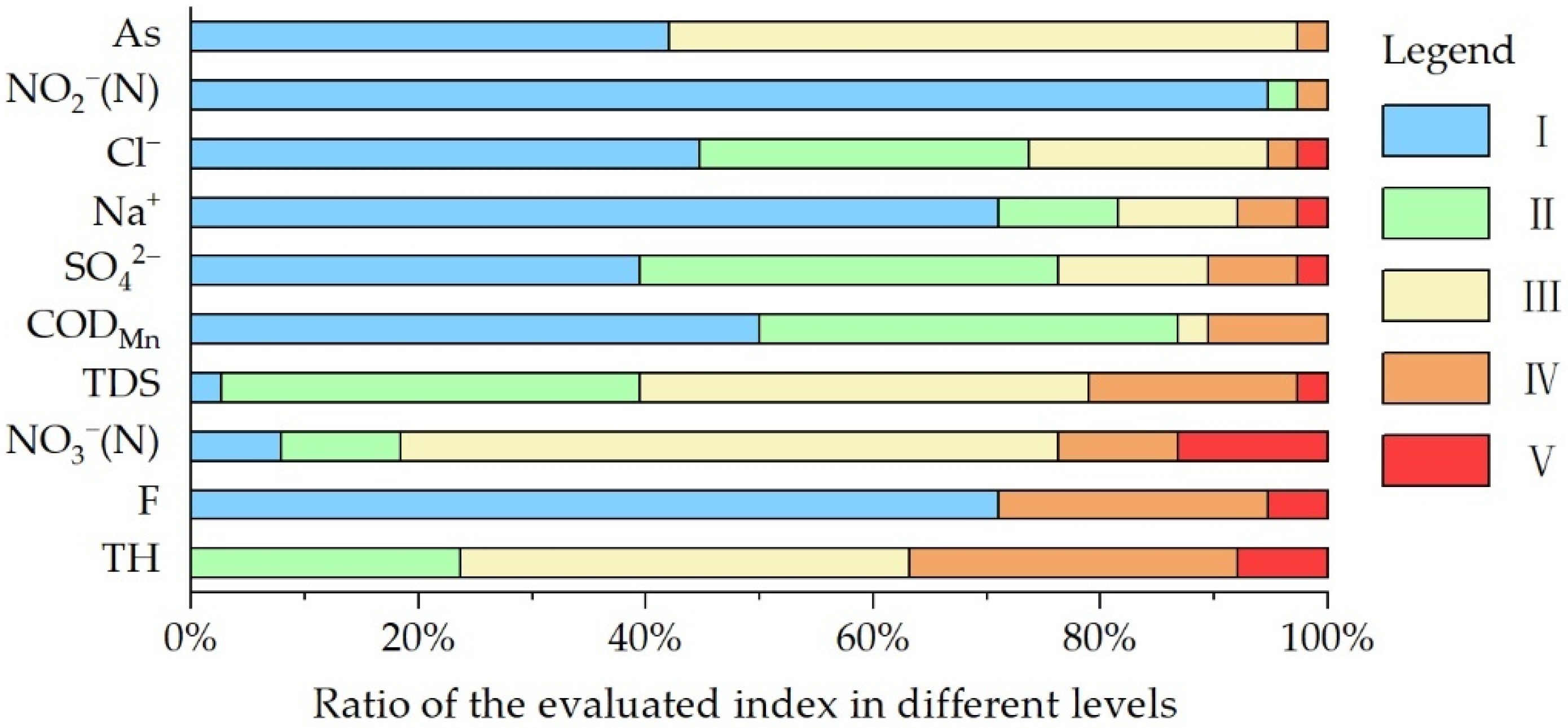
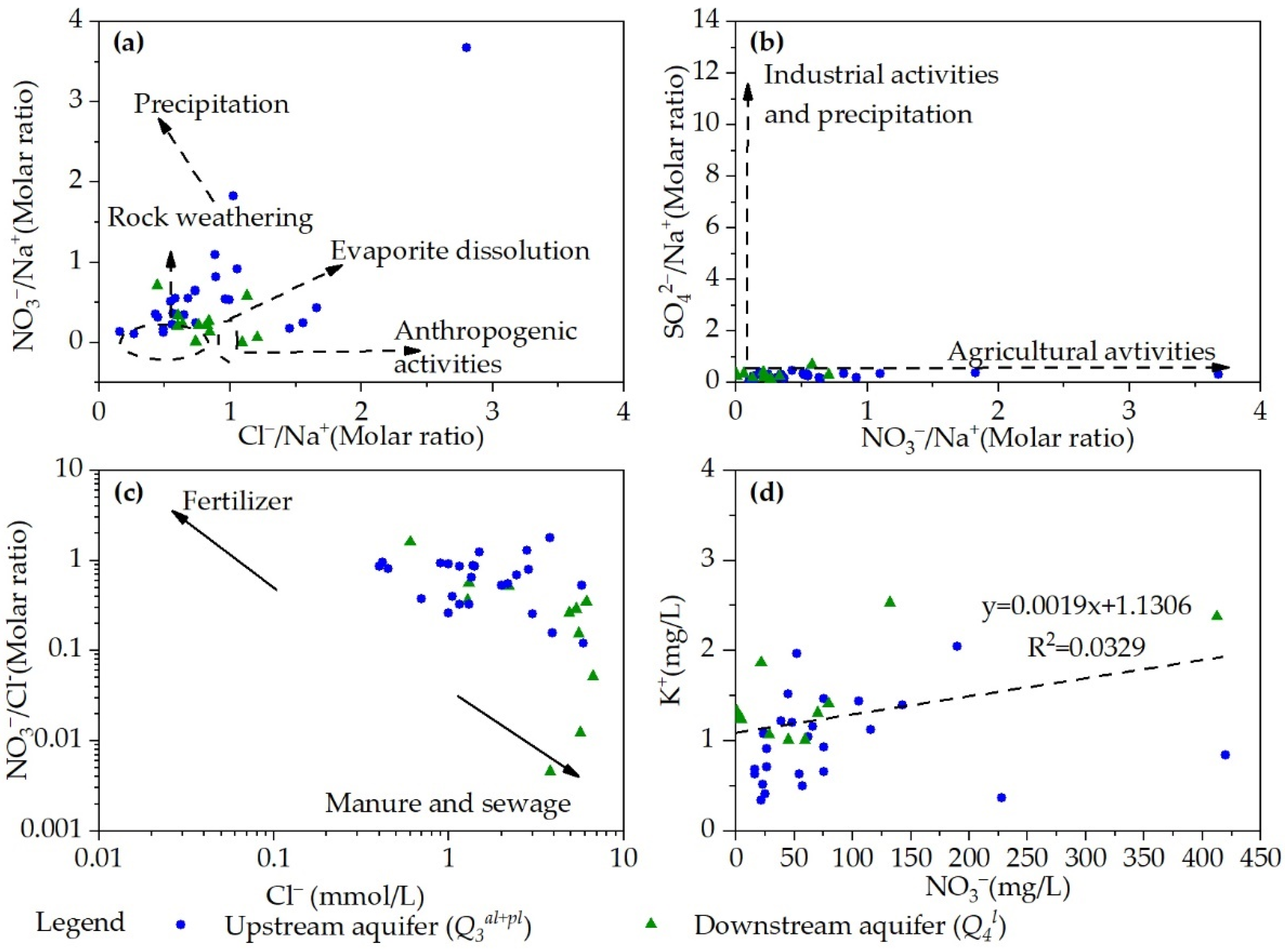
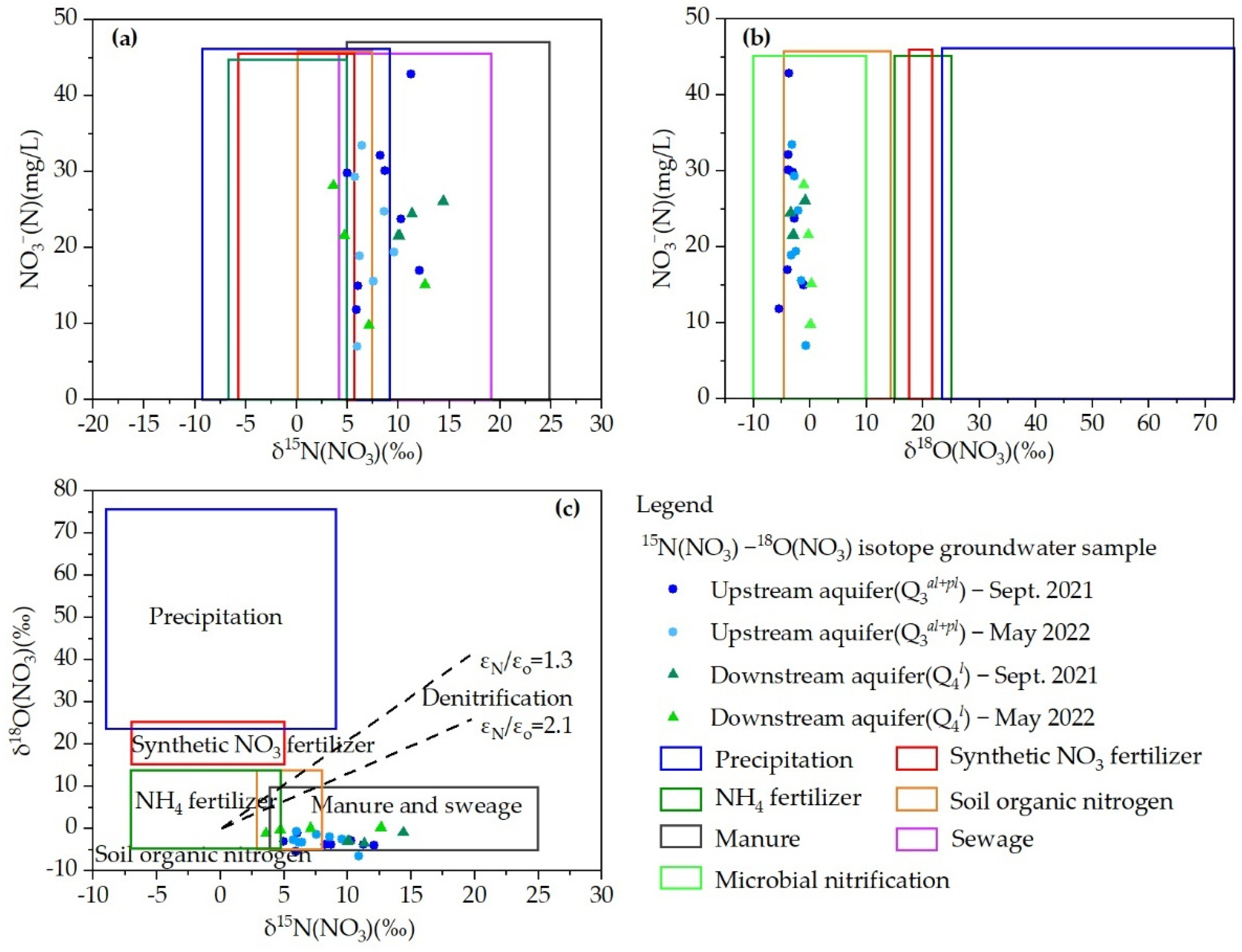
| Index | Level III | Index | Level III |
|---|---|---|---|
| pH | 8.5 | F− | 1 |
| TH | 450 | CODMn | 3 |
| TDS | 1000 | Fe | 0.3 |
| SO42− | 250 | Mn | 0.1 |
| Cl− | 250 | I | 0.08 |
| Na+ | 200 | Hg | 0.001 |
| NO3(N) | 20 | As | 0.01 |
| NO2(N) | 1 | Cr6+ | 0.05 |
| NH4(N) | 0.5 | Cd | 0.005 |
| Precipitation | Synthetic NO3 Fertilizer | NH4 Fertilizer | Soil Organic Nitrogen | Manure | Sewage | |
|---|---|---|---|---|---|---|
| δ15N(NO3) | −13~+13 | −6~+6 | −7~+5 | 0~+8 | +5~+25 | +4~+19 |
| δ18O(NO3) | +23~+75 | +17~+25 | +15~+25 | −5~+14 | −5~+10 | |
| Index | Maximum | Minimum | Average | Median | SD | Cv |
|---|---|---|---|---|---|---|
| pH | 8.58 | 7.38 | 7.82 | 7.81 | 0.24 | 3.03 |
| Ca2+ | 160.32 | 39.08 | 80.33 | 69.14 | 30.46 | 37.92 |
| Mg2+ | 413.27 | 13.37 | 60.95 | 43.51 | 64.39 | 105.64 |
| Na+ | 577.60 | 16.66 | 91.51 | 53.35 | 98.86 | 108.03 |
| HCO3− | 1677.97 | 213.56 | 386.78 | 340.17 | 237.28 | 61.35 |
| SO42− | 392.20 | 14.41 | 102.75 | 56.90 | 94.21 | 91.69 |
| Cl− | 744.51 | 14.18 | 114.69 | 74.10 | 129.57 | 112.97 |
| NO3− | 419.71 | 0.43 | 79.77 | 53.87 | 94.27 | 118.18 |
| NO2− | 1.35 | 0.00 | 0.04 | 0.00 | 0.22 | 561.36 |
| F− | 2.39 | 0.31 | 0.91 | 0.80 | 0.48 | 53.02 |
| H2SiO3 | 50.00 | 16.67 | 26.67 | 26.04 | 5.86 | 21.97 |
| TDS | 3426.54 | 287.03 | 744.56 | 568.66 | 545.20 | 73.22 |
| TH | 451.54 | 362.83 | 1851.67 | 152.64 | 1170.65 | 63.22 |
| CODMn | 5.07 | 0.12 | 1.44 | 1.01 | 1.11 | 77.23 |
| pH | Ca2+ | Mg2+ | Na+ | HCO3− | SO42− | Cl− | F− | H2SiO3 | TDS | TH | CODMn | |
|---|---|---|---|---|---|---|---|---|---|---|---|---|
| pH | 1 | |||||||||||
| Ca2+ | −0.114 | 1 | ||||||||||
| Mg2+ | −0.225 | 0.135 | 1 | |||||||||
| Na+ | −0.204 | 0.185 | 0.908 ** | 1 | ||||||||
| HCO3− | −0.226 | 0.040 | 0.968 ** | 0.915 ** | 1 | |||||||
| SO42− | −0.105 | 0.564 ** | 0.666 ** | 0.816 ** | 0.639 ** | 1 | ||||||
| Cl− | −0.294 | 0.308 | 0.912 ** | 0.951 ** | 0.869 ** | 0.794 ** | 1 | |||||
| F− | 0.290 | −0.229 | 0.550 ** | 0.487 ** | 0.563 ** | 0.267 | 0.359 * | 1 | ||||
| H2SiO3 | −0.188 | 0.000 | 0.596 ** | 0.477 ** | 0.528 ** | 0.205 | 0.565 ** | 0.079 | 1 | |||
| TDS | −0.224 | 0.352 * | 0.949 ** | 0.962 ** | 0.917 ** | 0.825 ** | 0.961 ** | 0.455 ** | 0.524 ** | 1 | ||
| TH | −0.239 | 0.392 * | 0.965 ** | 0.892 ** | 0.910 ** | 0.768 ** | 0.929 ** | 0.450 ** | 0.553 ** | 0.976 ** | 1 | |
| CODMn | −0.040 | 0.086 | 0.671 ** | 0.711 ** | 0.708 ** | 0.584 ** | 0.679 ** | 0.331 * | 0.345 * | 0.699 ** | 0.646 ** | 1 |
| Sample | Sampling Site | September 2021 | May 2022 | ||||
|---|---|---|---|---|---|---|---|
| δD | δ18O | d–Excess | δD | δ18O | d–Excess | ||
| H1 | Upstream aquifer (Q3al+pl) | −69.51 | −8.99 | 2.38 | −69.06 | −9.31 | 5.43 |
| H2 | −67.41 | −8.65 | 1.79 | −67.61 | −8.64 | 1.50 | |
| H5 | −74.58 | −9.91 | 4.70 | −74.93 | −10.08 | 5.73 | |
| H6 | −70.97 | −9.54 | 5.35 | −62.86 | −8.56 | 5.65 | |
| H8 | −68.60 | −9.33 | 6.01 | −67.74 | −8.97 | 3.98 | |
| H9 | −71.20 | −9.33 | 3.40 | −70.95 | −9.29 | 3.36 | |
| H12 | −68.89 | −8.89 | 2.23 | −68.32 | −8.92 | 3.04 | |
| H13 | −73.68 | −9.70 | 3.95 | −73.57 | −9.76 | 4.52 | |
| Average | −70.60 | −9.29 | 3.73 | −69.38 | −9.19 | 4.15 | |
| H3 | Downstream aquifer (Q4l) | −66.19 | −8.63 | 2.84 | −66.01 | −8.50 | 2.02 |
| H4 | −74.31 | −9.85 | 4.49 | −74.89 | −9.96 | 4.82 | |
| H10 | −61.01 | −7.53 | −0.81 | −60.68 | −7.39 | −1.60 | |
| H11 | −67.53 | −8.91 | 3.74 | −68.94 | −8.95 | 2.68 | |
| Average | −67.26 | −8.73 | 2.57 | −67.63 | −8.70 | 1.98 | |
| Index | Na+ | Cl− | SO42− | NO3(N) | NO2(N) | NH4(N) |
| Level III | 200 | 250 | 250 | 20 | 1.00 | 0.50 |
| Rover | 7.89 | 5.26 | 10.53 | 23.68 | 2.63 | 0.00 |
| M | 2.89 | 2.98 | 1.57 | 4.74 | 1.35 | / |
| Index | F− | TDS | TH | As | CODMn | |
| Level III | 1 | 1000 | 450 | 0.01 | 3 | |
| Rover | 28.95 | 21.05 | 36.84 | 2.63 | 10.53 | |
| M | 2.39 | 3.43 | 4.11 | 1.24 | 1.69 |
Publisher’s Note: MDPI stays neutral with regard to jurisdictional claims in published maps and institutional affiliations. |
© 2022 by the authors. Licensee MDPI, Basel, Switzerland. This article is an open access article distributed under the terms and conditions of the Creative Commons Attribution (CC BY) license (https://creativecommons.org/licenses/by/4.0/).
Share and Cite
Jin, J.; Wang, Z.; Zhao, Y.; Ding, H.; Zhang, J. Delineation of Hydrochemical Characteristics and Tracing Nitrate Contamination of Groundwater Based on Hydrochemical Methods and Isotope Techniques in the Northern Huangqihai Basin, China. Water 2022, 14, 3168. https://doi.org/10.3390/w14193168
Jin J, Wang Z, Zhao Y, Ding H, Zhang J. Delineation of Hydrochemical Characteristics and Tracing Nitrate Contamination of Groundwater Based on Hydrochemical Methods and Isotope Techniques in the Northern Huangqihai Basin, China. Water. 2022; 14(19):3168. https://doi.org/10.3390/w14193168
Chicago/Turabian StyleJin, Jing, Zihe Wang, Yiping Zhao, Huijun Ding, and Jing Zhang. 2022. "Delineation of Hydrochemical Characteristics and Tracing Nitrate Contamination of Groundwater Based on Hydrochemical Methods and Isotope Techniques in the Northern Huangqihai Basin, China" Water 14, no. 19: 3168. https://doi.org/10.3390/w14193168
APA StyleJin, J., Wang, Z., Zhao, Y., Ding, H., & Zhang, J. (2022). Delineation of Hydrochemical Characteristics and Tracing Nitrate Contamination of Groundwater Based on Hydrochemical Methods and Isotope Techniques in the Northern Huangqihai Basin, China. Water, 14(19), 3168. https://doi.org/10.3390/w14193168





